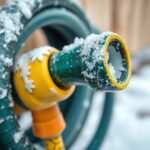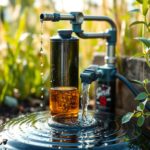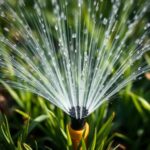Ultimate Guide: How Long and How Often Should I Run My Sprinkler System?

Proper lawn care is essential for maintaining a vibrant and healthy landscape, and an efficient sprinkler system plays a crucial role in this process. However, many homeowners are uncertain about how long and how often they should run their sprinklers to achieve optimal results. This ultimate guide will explore the best practices for scheduling your sprinkler system, taking into account factors such as climate, soil type, and plant needs. By understanding these essentials, you can ensure your lawn receives the right amount of water, conserving resources while promoting lush growth. Let’s dive into the key considerations for effective watering.
How Long and How Often Should I Run My Sprinkler System?
To maintain a healthy lawn and garden, it is essential to water effectively; typically, you should run your sprinkler system for about 30 to 60 minutes per session, depending on the type of soil, weather conditions, and the specific needs of your plants. Generally, watering should be done two to three times a week, allowing the soil to dry out between sessions to promote deep root growth. It's vital to adjust the duration and frequency based on rainfall and seasonal changes, ensuring that your outdoor spaces receive the optimal amount of moisture without water waste.
Frequency of Watering
The frequency of watering your garden or lawn largely depends on the climate, soil type, and the specific plants you have. In hot and dry climates, it may be necessary to water more frequently, perhaps three times a week, while in cooler, more humid areas, watering once a week might suffice. Ideally, establish a watering schedule that takes into account rainfall patterns, as this can help reduce the need for additional watering and conserve water.
Watering Duration
The duration of each watering session can vary based on the sprinkler type and the soil's absorption rate. A general recommendation is to water for 30 to 60 minutes at a time. Sandy soils may require a shorter duration because water drains quickly, whereas clay soils absorb water slowly, necessitating longer watering periods to ensure deep penetration. By ensuring adequate duration, you encourage deeper root development which leads to a healthier garden.
Seasonal Adjustments
As seasons change, so should your watering habits. In the spring and fall, when temperatures are moderate and humidity levels are higher, you may need to water less frequently than in the hot summer months. During winter, most plants require little to no supplemental watering, particularly in areas that experience frost. Pay attention to the needs of your plants, as some may require different watering schedules based on their growth cycle.
See also:
Soil Type Considerations
Different soil types have unique characteristics that affect how water is retained and absorbed. For example, sandy soils drain quickly and may require more frequent watering, while clay soils retain moisture for longer periods, thus requiring less frequent watering. For loamy soils, which provide a balance between drainage and retention, adjusting your watering schedule may be necessary. By understanding your soil type, you can optimize your sprinkler system's schedule to meet your landscape's needs effectively.
Watering Techniques
There are various watering techniques to consider for efficient use of your sprinkler system. Drip irrigation is particularly effective for gardens as it delivers water directly to the root zone with minimal evaporation and runoff. Sprinkler heads also vary in coverage and output; using rotating or spray heads can help distribute water evenly across your lawn and garden. Employing smart timers or moisture sensors can further enhance efficiency by automating your system based on the existing soil moisture levels.
| Aspect | Recommendation |
|---|---|
| Water Duration | 30 to 60 minutes |
| Watering Frequency | 2 to 3 times a week |
| Seasonal Adjustments | Adjust based on season |
| Soil Type | Consider drainage and retention |
| Watering Techniques | Use efficient methods like drip irrigation |
Factors That Influence Sprinkler Run Time
When determining how long and how often to run your sprinkler system, several factors come into play that can significantly affect the health of your lawn and garden. The climate in your region, the type of soil, the plant species, and the time of year all contribute to the optimal sprinkler schedule. For instance, hotter climates may require more frequent watering, while cooler regions might need less. It's essential to consider how quickly your soil absorbs water and the daily evaporation rates, as these will dictate how much water your plants receive without risking overwatering.
Understanding Soil Types
Different soil types (sand, clay, loam) have distinct water retention capabilities, impacting how often you should run your sprinkler system. Sandy soils drain quickly and may need more frequent watering, while clay soils retain moisture longer. Knowing your soil type allows you to adjust your sprinkler frequency and run time accordingly to ensure your plants receive the right amount of water without unnecessary waste.
The Importance of Seasonal Changes
As seasons shift, the watering requirements of your garden will vary. During the spring and summer, most plants require more frequent irrigation due to higher temperatures and increased evaporation rates. In contrast, during the fall and winter, plants typically need less water as growth slows down and natural precipitation becomes more prevalent. Adjusting your watering schedule according to the season is vital for the overall health of your landscape.
See also:
Weather Conditions and Their Impact
Weather conditions play a critical role in determining your sprinkler run time and frequency. For example, during a hot, dry spell, your plants may need additional watering to compensate for increased evaporation and stress. Conversely, after a rain event, it's wise to either skip your sprinkler run or reduce the duration to prevent overwatering, which can lead to root rot and other plant diseases.
The Role of Plant Species
Different plant species have varying water needs, making it essential to tailor your sprinkler system's schedule accordingly. For example, native plants often require less watering than more tropical or exotic varieties. Understanding the specific watering requirements of the plants in your garden enables you to customize your sprinkler run times, ensuring adequate moisture without leading to wasteful irrigation practices.
Timing and Duration of Watering
The timing and duration of your sprinkler runs significantly influence the effectiveness of your watering strategy. Early morning, when temperatures are cooler and wind is lighter, is generally the best time to run your system. Additionally, running your sprinklers for a longer duration but less frequently encourages deep root growth, which leads to healthier plants that can withstand drought conditions better. Adopting an appropriate routine ensures optimal moisture delivery without frequent interruptions.
Questions from Our Readers
How long should I run my sprinkler system each time?
Running your sprinkler system for about 15 to 30 minutes per zone is generally recommended. This duration allows the water to absorb deeply into the soil, ensuring that the roots of your plants and grass receive adequate moisture without causing runoff.
How often should I run my sprinkler system?
Typically, you should run your sprinkler system two to three times a week, depending on your local climate and soil conditions. In hotter months, you might need to increase the frequency to maintain healthy, hydrated lawns and gardens.
See also:
Does the type of plants affect how long I should run my sprinkler system?
Yes, the type of plants you have can influence the duration of your sprinkler usage. Drought-resistant plants may require less watering time compared to thirstier species, so it's important to adjust your settings based on the specific needs of your garden.
What factors should I consider when scheduling my sprinkler system?
When scheduling your sprinkler system, consider factors such as weather conditions, soil type, and plant types. Additionally, watering early in the morning or late in the evening can help minimize evaporation losses, improving the effectiveness of your sprinkling.

If you want to read more articles like Ultimate Guide: How Long and How Often Should I Run My Sprinkler System?, we recommend you check out our Irrigation category.
Leave a Reply
Related Articles